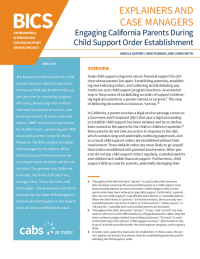Explainers and Case Managers
Engaging California Parents During Child Support Order Establishment

An essential step in the process of establishing an order of child support is delivering legal documents to a person named as a parent. This step of delivering documents is known as “service.”
In California, a parent receives a legal service package known as a Summons and Complaint (S&C) that says a legal proceeding to establish child support has been initiated and he or she has been named as the parent for the child or children in question. Many parents do not take any action in response to the S&C, which contains long and potentially confusing paperwork, and as a result child support orders are established without their involvement. These default orders are more likely to go unpaid than orders established with parental involvement. When parents do not pay child support orders regularly, custodial parents and children lack stable financial support. Furthermore, child support debt accrues for parents, potentially damaging their credit, and enforcement actions such as driver’s license suspension and contempt-of-court proceedings can be taken against them.
The child support agencies in Sacramento County and San Joaquin County worked with the Behavioral Interventions for Child Support Services team to test whether a behavioral intervention would increase parents’ engagement in the order establishment process. Their primary goal was to increase the percentage of orders established by stipulation or hearing — order types that indicate parent engagement — and reduce the percentage established by default. A related goal was to increase the number of parents who submitted a specific form, known as the Answer form, in response to service.
The intervention had several components that were the same in both counties. First, specially trained BICS case managers focused only on the order establishment process and on implementing the intervention. Second, these case managers added a simple explainer sheet available in English or Spanish to the front of the S&C and moved the Answer form in the S&C package so that it was directly behind the explainer instead of buried in the middle. Third, the BICS case managers called parents after service to explain how to fill out the Answer form. Finally, they called parents again if the Answer form was submitted, explaining the next steps parents needed to take.
The intervention produced positive, statistically significant impacts on:
-
Answer forms filed (3.1 percentage points)
-
Orders established at court hearings or by stipulation (3.2 percentage points)
-
Child support payments ($93 on average, from $351 paid on the study order in the control group to $444 paid in the intervention group)
However, it is likely that some of these impacts largely reflect an unintended outcome of the intervention — increased rates of service — rather than the effects of the intervention components operating as planned. More parents in the intervention group (74.6 percent) were successfully served than parents in the control group (69.6 percent). This statistically significant “service effect” is good in its own right because it is important to the order establishment process that parents receive the S&C packages. Unfortunately, this service effect makes it difficult to determine whether the intervention components or the increased rate of service are responsible for the positive impacts on Answer forms filed, orders established, and payments.
There is some evidence to suggest that the intervention components (rather than the service effect alone) contributed to the statistically significant impact on orders established at hearings or by stipulations, particularly in San Joaquin County.
Another important finding is that the intervention increased overall order establishment by 17.1 percentage points among Spanish speakers, while increasing it by only 4.1 percentage points among English speakers. The impacts are statistically significant in both subgroups, and the difference between the two subgroups’ impacts is also statistically significant, meaning the intervention was more effective at increasing order establishment among Spanish-speaking parents.






